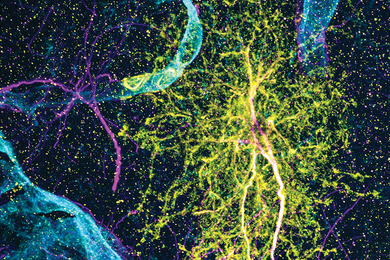CAMBRIDGE, Mass.--Scientists at the Massachusetts Institute of
Technology have discovered that an area of the brain previously thought
to process only simple visual information also tackles complex images
such as optical illusions.
The research, conducted with animals, also provides evidence that
both the simple and more complex areas of the brain involved in
different aspects of vision work cooperatively, rather than in a rigid
hierarchy, as scientists have believed to date.
"Because half of the human brain is devoted directly or indirectly
to vision, understanding the process of vision provides clues to
understanding fundamental operations in the brain," said Professor
Mriganka Sur of MIT's Department of Brain and Cognitive Sciences. The
research, which will appear in the December 20 issue of the journal
Science, was conducted by Professor Sur, graduate student Bhavin R.
Sheth, and postdoctoral fellows Jitendra Sharma and S. Chenchal Rao, all
of the same department.
"We've found that even supposedly simple parts of the brain are
doing complex, sophisticated processing of such things as visual
illusions," said Mr. Sheth . "By knowing what various parts of the brain
do, we can make predictions about how the brain will function if parts
of it have to be removed or if there is some sort of trauma."
Mr. Sheth compares vision to an orchestra, where clusters of cells
in different parts of the brain cooperate to process different
components of visual information such as vertical or horizontal
orientation, color, size, shape, movement, and distinctions between
overlapping objects.
The MIT research focused on an area of the cerebral cortex--the
outer layer of gray matter that envelops the entire brain--called the
primary visual cortex, also known as V1 and Area 17 of the brain. In
humans that area is about five centimeters in diameter--the size of four
postage stamps--and a couple millimeters deep on both sides of the rear
of the head, just below the crown.
The V1 area is the first point of entry in the brain's cortex of
visual information from the eye's retina. V1 has to date been thought to
be involved only in processing very simple spatial orientations, such as
whether an object is placed vertically or horizontally, but not whether
that object is a pencil or a finger.
Using optical imaging techniques to record visual responses in cats
over the past two-and-one-half years, the researchers found that V1 can
also process optical illusions and other complex images. The researchers
said the same is likely to be true in the V1 area of the human brain.
For example, if a person takes a sheet of notebook paper with
horizontal lines and places an identical sheet as close as possible to
the right of it and slightly lower, the lines on both pages won't
connect in a continuous straight line. Yet the brain's visual processing
system will try to fill the space between the two sets of real lines by
creating an optical illusion known as a subjective contour.
Subjective contours are higher-level visual functions that involve
the brain's understanding the context and relationship of the images,
not just the static placement of one set of lines next to another.
Another example is a telephone: a handset may obscure part of the phone
base under it, but the brain's visual processes will see both the
handset and the entire phone base as two distinct objects that belong
together.
"We are just beginning to understand the brain mechanisms that
underlie complex cognitive processes in vision," Professor Sur
explained. "Our work is the first and most important step in showing
that right in the earliest stages of the visual cortex, where visual
input first enters the brain, there are groups of cells that break down
these stimuli and respond to them. That leaves open the question of how
higher-order visual cortex areas further process these kinds of
stimuli."
The discovery of complex subjective contour processing in the V1
area is bolstered by earlier work in Professor Sur's laboratory with
Louis Toth, a former MIT graduate student (MIT PhD '95) now conducting
brain research at Harvard Medical School.
In a September 1996 paper in the Proceedings of the National
Academy of Sciences, Professor Sur, Dr. Toth and colleagues reported
that V1 could also be the site of "filling-in," another function
traditionally thought to be high-level. "Filling-in" is when the brain
compensates for a lack of information in one area of the visual field by
making an educated guess from information elsewhere in the visual field.
It explains why patients with small lesions don't see black spots, and
why you are not aware of your "blind spot."
The knowledge gained from both experiments can be applied to other
brain areas and functions, Dr. Toth said. For example, Dr. V.S.
Ramachandran from the University of California, San Diego, who has also
studied "filling-in" phenomena in vision, is interested in how the
similar wiring of the part of the brain that detects touch may explain
why amputees perceive "phantom limbs."
"The way the visual cortex is 'wired' is similar to the way the
rest of the brain's cortex is 'wired,'" said Dr. Toth.
Professor Sur said this is a very important concept in
understanding the brain, because from merely an anatomical or structural
study of the brain, different areas of the cortex look remarkably
similar. What distinguishes the different areas of cortex is the inputs
they get and how these inputs get processed and then farmed out to
different areas.
"So if one knows that an area of the brain with its connection and
circuitry does a certain kind of thing, one immediately sees the
possibility that all areas of the brain can do similar things to their
respective inputs," Professor Sur said. "This is a very powerful idea."
The work was supported by the National Institutes of Health.





